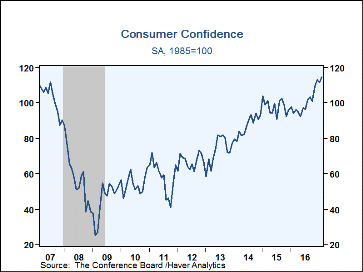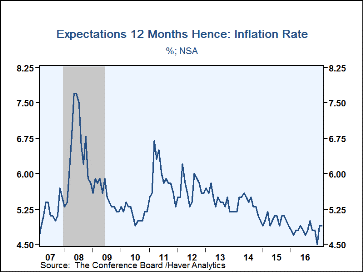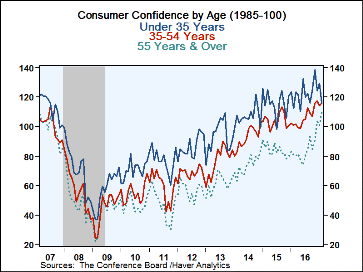 Global| Feb 28 2017
Global| Feb 28 2017U.S. Consumer Confidence Strengthens to 2001 High
by:Tom Moeller
|in:Economy in Brief
Summary
The Conference Board Consumer Confidence Index for February jumped to 114.8, the highest level since July 2001. The Action Economics Forecast Survey had looked for a modest decline to 111.0. During the past thirty years, there has [...]
The Conference Board Consumer Confidence Index for February jumped to 114.8, the highest level since July 2001. The Action Economics Forecast Survey had looked for a modest decline to 111.0. During the past thirty years, there has been a 70% correlation between the level of consumer confidence and the y/y change in real PCE.
The rise in confidence was due to a strengthened present situation reading of 133.4 (16.0% y/y). Also increasing was the expectations figure to 102.4 (17.0% y/y).
Respondents indicating that business conditions are "good" was steady at 28.7%, while those saying business conditions are "bad" eased to 13.2%. Respondents stating that jobs are "plentiful" slipped to 26.2%, while those claiming jobs are "hard to get" fell to 20.3%. This change in views on labor market conditions led to a steady labor market differential (a reliable indicator of the unemployment rate) of 5.9 percentage points, which was near the highest level since 2007.
The percentage expecting business conditions to improve over the next six months rose to 24.0%, near the recovery high. For labor markets, the percentage expecting more jobs in the months ahead gained to 20.4%, also near the recovery high. The percentage of consumers expecting their incomes to rise held steady 18.3%, but was down from the December high of 21.5%.
Expectations for the inflation rate in twelve months held steady at 4.9%, the highest level since September. The percentage expecting higher interest rates over the next twelve months reversed the January surge with a decline to 67.0%.
The rise in the headline confidence index was due to improved optimism amongst individuals over age 55. Confidence amongst individuals aged 35-to-54 also increased. Respondents under age 35 registered less confidence, which was well off versus the June high.
The Consumer Confidence data is available in Haver's CBDB database. The total indexes appear in USECON, and the market expectations are in AS1REPNA
| Conference Board (SA, 1985=100) | Feb | Jan | Dec | Y/Y % | 2016 | 2015 | 2014 |
|---|---|---|---|---|---|---|---|
| Consumer Confidence Index | 114.8 | 111.6 | 113.3 | 22.1 | 99.8 | 98.0 | 86.9 |
| Present Situation | 133.4 | 130.0 | 123.5 | 16.0 | 120.6 | 111.7 | 87.4 |
| Expectations | 102.4 | 99.3 | 106.4 | 17.0 | 86.1 | 88.8 | 86.6 |
| Consumer Confidence By Age Group | |||||||
| Under 35 Years | 116.3 | 129.2 | 124.4 | 33.7 | 122.4 | 116.0 | 106.6 |
| Aged 35-54 Years | 116.1 | 114.2 | 117.0 | 14.7 | 106.2 | 103.9 | 92.4 |
| Over 55 Years | 110.0 | 102.1 | 103.7 | 36.0 | 84.6 | 84.1 | 73.8 |
Tom Moeller
AuthorMore in Author Profile »Prior to joining Haver Analytics in 2000, Mr. Moeller worked as the Economist at Chancellor Capital Management from 1985 to 1999. There, he developed comprehensive economic forecasts and interpreted economic data for equity and fixed income portfolio managers. Also at Chancellor, Mr. Moeller worked as an equity analyst and was responsible for researching and rating companies in the economically sensitive automobile and housing industries for investment in Chancellor’s equity portfolio. Prior to joining Chancellor, Mr. Moeller was an Economist at Citibank from 1979 to 1984. He also analyzed pricing behavior in the metals industry for the Council on Wage and Price Stability in Washington, D.C. In 1999, Mr. Moeller received the award for most accurate forecast from the Forecasters' Club of New York. From 1990 to 1992 he was President of the New York Association for Business Economists. Mr. Moeller earned an M.B.A. in Finance from Fordham University, where he graduated in 1987. He holds a Bachelor of Arts in Economics from George Washington University.










